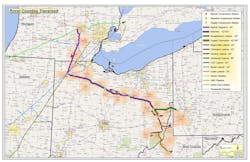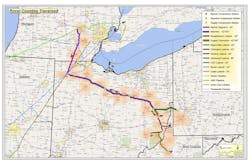Ohio EPA concerns lead FERC to partially halt work on Rover Pipeline
The US Federal Energy Regulatory Commission ordered Rover Pipeline LLC to not begin new horizontal directional drilling (HDD) as it constructs the natural gas transmission project across Ohio. But the May 10 order, which FERC issued in response to the Ohio Environmental Protection Agency’s May 5 letter beginning enforcement actions following bentonite slurry discharges and other matters along the route, allowed the Energy Transfer Partners (ETP) unit to continue HDD work that is under way.
In such areas, stopping drilling could lead to the loss of the bore hole and cause more prolonged environmental impacts, FERC said.
“Construction along the route continues including the drills where remediation has been completed,” an ETP spokeswoman told OGJ on May 11. “Construction has been stopped at the specific HDD sites specified in the letter from FERC. To date, excluding the Stark County site where efforts continue, remediation has been completed at all other sites where inadvertent releases have occurred.”
FERC approved construction on Feb. 3 of the 713-mile, 42-in. system from southeastern Ohio, western West Virginia, and southwestern Pennsylvania gas production areas to an interconnection in northwestern Ohio, where it would then continue north to its termination in Livingston County, Mich. The 3.25-bcfd capacity project’s first phase is scheduled to begin service in July, followed by its second phase in November.
Ohio EPA contacted FERC on May 5 as it separately sent Rover Pipeline proposed administration orders covering remedial actions from six bentonite slurry discharges totaling more than 2 million gal into nearby wetlands during Apr. 8-22. Additional proposed orders dealt with unauthorized discharges and water-quality violations, and an opening burning violation.
Letter to Ohio EPA
In an Apr. 28 letter to Ohio EPA Director Craig W. Butler, Joey Mahmoud, Rover’s executive vice-president for engineering and construction, said the company and its contractors would:
• Immediately notify Ohio EPA and other applicable state and federal agencies of any releases, including certain advance notifications of predicted drilling circulation or returns which could be lost during the drilling process. Rover also would begin discussions with the agency to identify alternative drilling techniques to so inadvertent release points could be identified.
• Expand its evaluation radius to adjacent properties and areas to monitor via direct land access, aerial evaluation, and drones to assist in identifying an inadvertent release.
• Continue to pre-stage response equipment, materials, and staff in the event that inadvertent releases occur, including the addition of more redundant equipment and drill-specific evaluations.
• Continue to temporarily halt and slow down drilling when returns are lost to the minimum turning rotation and pressure requirements to advance the drill in an attempt to either seal the release point in the subsurface drill hole or possibly identify the release’s location to quickly contain and implement plans and recovery efforts.
• Continue to provide a toll-free hotline for landowners and other concerned stakeholders to call. Rover also planned to republish the information in local newspapers and renotify landowners near the HDD operations, and provide the hotline number to local community leaders for distribution. It also has provided each stakeholder along the right-of-way (ROW) a direct phone number to agents supporting the construction.
• Schedule additional inspections and hire more third-party drilling monitors as well as trained staff to look for inadvertent releases. Drilling also will be monitored to ensure added vigilance is deployed to manage the timeliness and speed of the drill’s execution.
• Continue to deploy necessary resources to comply with Ohio EPA and FERC stormwater control requirements, including training staff on water filtration, trench dewatering, and off-ROW tracking of mud, slope-breakers, and sediment contamination.
• Emphasize to contractors and employees to be aware of and take immediate steps to protect wetlands, streams, and other water resources, and to reinforce as necessary any existing sediment control techniques to improve sedimentation off the ROW.
• Monitor the amount of open ditches and disturbed land, as well as the duration of exposed soils, and deploy necessary soil stabilization techniques to minimize the amount of sediment generated from construction work locations.
• Increase efforts to stabilize temporary spoil piles during construction.
Letter to Rover Pipeline
In its May 5 letter to Rover Pipeline, Ohio EPA ordered the company to immediately implement a release prevention and emergency contingency plan which it submitted for review and the agency approved on Apr. 29.
It also required Rover to submit a wetland restoration plan for affected areas Ohio EPA identified within 30 days, submit a notice of intent to acquire coverage under an Ohio EPA stormwater construction permit within 7 days and submit a stormwater prevention plan for review and approval within 14 days, and pay $431,000 to settle Ohio EPA’s civil penalty claims within 30 days.
In his May 10 letter to Mahmoud, FERC Energy Projects Office Director Terry L. Turpin said that the federal energy transportation regulator was ordering Rover Pipeline to not commence new HDD activity after 2 million gal of bentonite slurry leaked onto Category 3 wetlands adjacent to the Tuscarawas River in Stark County, Ohio, on Apr. 13.
He said after FERC staff members reviewed information from the compliance monitor, drilling logs, geotechnical bore logs of the subsurface geology, and staff’s onsite inspection, they found returns of drilling mud were absent or intermittent during the nearly 3 weeks that the pilot drill, the 30-in. ream, and the 40-in. ream were completed.
“During this period of absent (or intermittent) returns to the drilling rig, Rover continued to advance the drilling activities,” Turpin said.
Based on this information—as well as the volume, extent, and condition of drilling mud in the wetland—FERC’s staff had serious concerns about the incident’s magnitude, which was several orders greater than other documented HDD inadvertent returns for the project; its environmental impacts; the lack of clarity regarding underlying reasons for its occurrence; and the possibility for future problems, he told Mahmoud.
“Given that the site of the release extended near, and extended over Rover’s approved centerline, a stoppage of additional drilling is warranted to facilitate a review of Rover’s efforts to search for and locate any potential releases,” Turpin said.
An Ohio EPA spokesman told OGJ on May 11 that the agency was pleased with FERC’s action, and intends to pursue its proposed administrative orders. While the enforcement action includes a civil penalty, Ohio has not yet levied a fine against Rover, he noted.
Contact Nick Snow at [email protected].
About the Author

Nick Snow
NICK SNOW covered oil and gas in Washington for more than 30 years. He worked in several capacities for The Oil Daily and was founding editor of Petroleum Finance Week before joining OGJ as its Washington correspondent in September 2005 and becoming its full-time Washington editor in October 2007. He retired from OGJ in January 2020.

